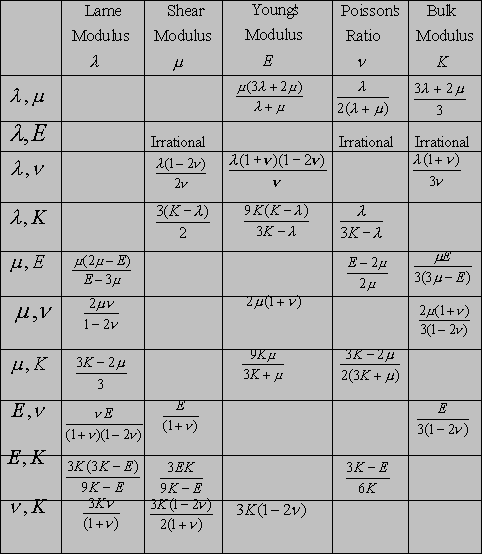 EN224:
Linear Elasticity
EN224:
Linear Elasticity

 EN224:
Linear Elasticity
EN224:
Linear Elasticity

Division of Engineering
1.3 Constitutive Law for Linear Elastic Solids
![]() Objective: find relationship between
Objective: find relationship between ![]() , assuming infinitesimal
motion
, assuming infinitesimal
motion
As before, we will begin by reviewing constitutive models for large deformations.
We will define an elastic solid from thermodynamic considerations.
We make two key assumptions regarding the behavior of the solid:ASSUMPTION 1: Local Action
Stress at a point X depends only on the deformation of the immediate neighborhood of X.
Implication: we need only specify the response of the solid to homogeneous deformation (recall that all smooth deformations are locally homogeneous).
ASSUMPTION 2: Equation of State
State is completely characterized by Lagrangean strain E and temperature q
Hence, there exists a specific internal energy u(E,s),
where s is the specific entropy.
Measuring u(E,s) and s(E,q)
would completely characterize the material.
Given u(E,s) and s(E,q), we may define the Helmholz free energy
Given u or F, we can find the stress-strain-temperature response of the solid:
I: Isothermal deformations
Consider quasi-static state change
Then

Now, recall the first law of thermodynamics
Where dw is the work done on the solid per unit reference volume, and dq is the heat flow into the solid per unit reference volume.
From the power identity and the second law:
Where
is the second Piola-Kirchhoff stress.
Hence, comparing the two expressions for du shows that

II: Isentropic deformations
Consider a quasi-static state change

Now,
So
Hence

Thus, we have two alternative expressions for the stress. We will write

Linearized constitutive law
We proceed to linearize the general stress-strain response. To this end, we suppose that E is small in some sense (we only know what `small’ means if we know the form of the expressions for
). In addition, assume that the reference configuration is stress free (it is trivial to generalize to stressed reference configurations).
Then, expand the expressions for
to first order in E


To simplify, we introduce the elastic constants
 Adiabatic elastic constants
Adiabatic elastic constants Isothermal elastic constants
Isothermal elastic constants.Similarly, define


It is worth noting for future reference that u and F are positive definite.
Voigt Symmetries
Our two assumptions impose three restrictions on the elastic constants
1.
(since )
2.
(since )
3.
(because of 1. and 2.)
Thus,
has 21 independent constants.
Linear Elastic stress-strain-temperature relations
We now introduce the approximations discussed in 1.1; 1.2.
Let
Then
We could invert these expression. Let



Then

Some terms:
are the components of the elasticity tensor
are the components of the compliance tensor
are the components of the thermal expansion coefficient
![]() Observations
Observations
For (a) Isothermal or (b) Adiabatic, isentropic processes
A solid with this constitutive law is called a Linear Simple Solid.
Note that we could measure the elastic constants
under either isothermal or adiabatic conditions. The two tests do not give the same values. However, the difference is very small and we usually do not distinguish between and . We will drop the distinction from now on.
Note that the symmetries of C allow us to write an expression relating stress directly to displacements:
The second term on the RHS vanishes (can you show this?), and
So
Strain Energy Density
The structure of the constitutive relations outlined above has an important consequence. One may readily show that for a linear simple solid, there exists a scalar potential f such that

This holds if and only if
, in which case f is given by
The proof is left as an exercise.
Elastic Symmetries
A general anisotropic solid has 21 independent elastic constants.
Note that in general, tensile stress may induce shear strain, and shear stress may cause extension.
If a material has a symmetry plane, then applying stress normal or parallel to this plane induces only extension in direction normal and parallel to the plane

For example, suppose the material contains a single symmetry plane, and let
be normal to this plane.
Then
(symmetrical terms also vanish, of course).
This leaves 13 independent constants
Orthotropic material
An orthotropic material has three mutually perpendicular symmetry planes:

This type of material has 9 independent material constants. Choose basis vectors perpendicular to each symmetry plane, then:
Isotropic Material
The response of an isotropic solid is independent of the orientation of the loading axes wrt the material.
For this case, C must be an isotropic tensor.
From the representation theorem for isotropic tensors (see Atkin and Fox, 1980) C must have the form
Where l, m and g are constants.
To satisfy
, we must have m = g.
Hence,
or
This expression may be inverted (contract i and j, solve for
and substitute back)

Where the last term is the strain due to thermal expansion.
l and m are known as the Lame constants.
Several other forms of this constitutive relation are often used:
Here, E and n are Young’s Modulus and Poisson’s ratio, respectively, while K is the bulk modulus.
Relations between the constants are tabulated below

Restrictions on Values of Elastic Constants
Recall that thermodynamic considerations require that
for all
.
We will show that
, or
Begin by expressing
in terms of the stress invariants. Note that
Recall that the invariants of
are
Hence
Observe that since
may be expressed in terms of the stress invariants, it is independent of our choice of basis. Hence, we could just as well express
in terms of the principal stresses. It is straightforward to show that
Finally, to prove our assertion, consider particular stress states.
Let
To prove the converse, write
Whereupon it is clear that for nonzero states of stress